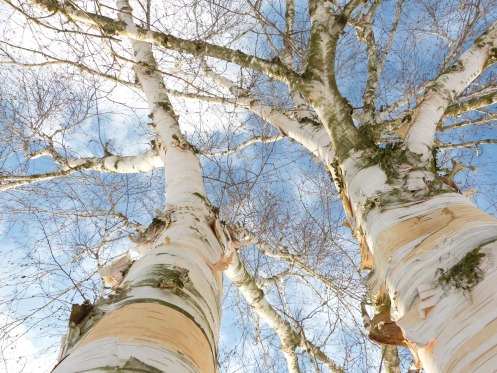Birch are lovely trees and flourish if well watered.
The lovely birch -- except for one tough native, the black or river birch, all birch are swamp trees. It is important to know from where in nature your tree's relatives come. That said, planting a birch on the dry prairies is not a practical thing to do. If you really want one, plant it, water it and water it again, don't stop watering, ever. As it gets bigger it uses more water. The graceful cutleaf weeping birch has the highest water requirements of any tree that grows here. Regularly well watered, they are beautiful, but many of them have dead tops furthest from the water source, with other problems that a struggling tree will have, such as excessive insect population, deadwood, a wilted look.
Because of their swampside origins birch have very shallow roots; if they didn't, they would drown. What this means is that they are in the very top layer of the soil, drying out the fastest and in direct competition with turf and any other nearby plant.
Birch have a number of common problems. Leaf miners would top the list. A well-watered tree, especially a birch, can do an amazing job of fighting its predators. Leaf miners never kill a tree, drought kills a birch.
Another insect that is unnecessarily blamed a lot is the bronze birch borer. Never a pioneer, this fairly harmless insect works in birch trees that are already dehydrated, weak and heading toward trouble. I have never seen the bronze birch borer in even a reasonably healthy tree.
Pruning the birch deserves some discussion. Not all wood is made the same way and different patterns do exist. Birch belong to a group of trees whose wood is called diffuse porous. This means that the active upward transport vessels are laid down evenly throughout the growth ring each year. This allows for some interesting things to happen. When diffuse porous trees are wounded during the dormant period, when spring comes they flush out a lot of sap trying to deal with the wound. The human equivalent would be a person whose cuts don't readily stop bleeding. This is also the story of the making of maple syrup. Once the tree leafs out the sap flow from the wound quits. If pruned during the growing season, when the tree is full of green leaves, the tree will not lose any sap from the wound, or pruning sites.
That said I think birch have enough problems on their own, and so I only prune them when they are green and in full leaf.
Types of birch:
The cut leaf was dealt with above.
The white birch is also called canoe birch because of its essential connection with the early North American fur trade. The white birch is more drought resistant than its weeping cousin, but that doesn't mean hold back the water. It is often grown in clumps; three, five or seven trunks are visually appealing. The same ideas about pruning, watering and insects apply to the white birch as to the cutleaf weeping birch.
Another interesting birch is the Young's weeping birch, a true weeping form that has each year's current leaders bending back down towards the roots.
One other is the native multi-trunked river birch or black birch, which looks like a shrub most of the time. I have seen them planted in gardens; they keep their multi-trunk form but can attain a good size, 25 feet high with trunk diameters of 10 inches. In nature, usually on dry south facing slopes, it is extremely drought hardy. This would be the choice if wanting a zeroscape birch.
--









